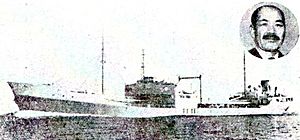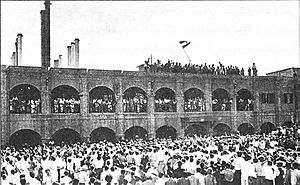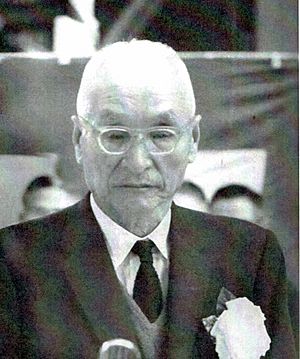Nissho Maru Incident facts for kids
The Nissho Maru Incident was a big event in 1953. It happened when a Japanese ship bravely broke an oil trading ban that the United Kingdom had put on Iran. This bold action connected Iran, a top oil producer, with Japan, a country that needed a lot of oil. Because of this, the price of oil in Japan dropped a lot, which was great for people buying it.
A British company, Anglo-Iranian Oil Company (AIOC), tried to stop the Nissho Maru and take its oil. But courts in Tokyo said no. The British company tried for years but didn't win. When the Nissho Maru arrived in Kawasaki, Japan, everyone cheered for it like a hero. For Japan, this event gave people hope and pride after World War II. For Iran, it was a small but important win against Britain and the United States.
Contents
Why Was There an Oil Ban?
After Iran's Prime Minister Mohammed Mossadegh took control of British oil businesses in Iran, Britain reacted strongly. British warships blocked the oil port of Abadan. On August 22, 1951, Britain stopped selling important goods like sugar to Iran. They also froze Iran's money in British banks.
In July 1952, the Royal Navy (Britain's navy) stopped an Italian ship called Rose Mary. They forced it to go to Aden, saying its oil was stolen from Iran. News of the Royal Navy stopping ships scared other oil tankers away. This made it very hard for Iran to sell its oil. The United States, led by President Harry Truman, supported Britain's tough stance against Iran.
Idemitsu Kosan: A Brave Japanese Company
In Japan, the American control after the war ended in April 1952. A Japanese oil company called Idemitsu Kosan wanted to grow again. During World War II, the Japanese government controlled oil. But Idemitsu got a special permit in 1949 to sell oil to both businesses and people.
Idemitsu started bringing in good quality gasoline from the U.S. and sold it in Japan under the name "Apollo." In 1951, the Japanese government allowed Idemitsu Kosan to build a new oil tanker. They named it the Nissho Maru. This ship was built in the Harima Shipyard. It was very big for its time and cost a lot of money to build. The company's leader, Sazo Idemitsu, had to borrow money.
Idemitsu used this new tanker to bring in special gasoline from California. But soon, big U.S. oil companies started to limit how much oil they would sell to Idemitsu. Idemitsu tried buying oil from Houston, Texas, but faced limits there too. Finally, they found a supplier in Venezuela.
Because of these problems, the fight between Britain and Iran gave Idemitsu a special chance. Idemitsu needed oil that was easy to get and not too expensive. Iran needed someone brave enough to trade with them, even with Britain's ban. This led to secret talks starting in 1952. The Japanese government was worried about upsetting Britain. So, Idemitsu secretly sent his managing director, ja:Keisuke Idemitsu, to Iran to talk. He met with Iranian leaders, including Prime Minister Mohammad Mossadegh.
Buying and Delivering the Oil
At first, Iran didn't fully trust Idemitsu. Other companies had promised to trade but didn't follow through. Also, Idemitsu was a medium-sized company, not well-known outside Japan. But after many talks, they reached an agreement. They discussed how to follow laws and avoid problems for the Japanese government. Iran agreed to sell oil to Idemitsu at a 30% lower price than the market price.
The Nissho Maru set sail on March 23, 1953. It reached Abadan without the Royal Navy noticing. People in Abadan were so happy when the ship arrived. They greeted it with flowers, sweets, and festive music. At this point, news of the event spread worldwide. It became a big international story. In Japan, it was front-page news. People saw it as a small, private company challenging the Royal Navy, which was the second-largest navy in the world.
On April 15, the Nissho Maru, full of oil, left Abadan. The whole world was watching. It sailed through tricky waters and avoided the Royal Navy's blockade. The ship arrived at Kawasaki Port at 9 AM on May 9.
The Court Case
The Anglo-Iranian Oil Company sued Idemitsu in the Tokyo District Court. They said the oil cargo belonged to them. At the same time, Britain put pressure on the Japanese government to take the oil.
However, the United States didn't like Britain having all the oil control. Also, the Japanese public supported Idemitsu. So, the Japanese government didn't take any action against Idemitsu. The court sided with Idemitsu. On May 27, the court said the oil could not be taken. Anglo-Iranian appealed the decision, but they dropped their appeal on October 29. This meant Idemitsu won!
Important Dates
1951
- March - Work began on building the Nissho Maru. It was a very large ship.
- September 8 - The San Francisco Peace Treaty was signed, making Japan independent again.
1952
- June 15 - The Rose Mary ship was stopped by the Royal Navy in the Arabian Sea.
- September 26 - The Nissho Maru was officially launched.
- October 22 - Iran announced it was ending its diplomatic ties with Britain.
- November 5 - Keisuke Idemitsu and Haruo Teshima left Japan for Iran.
- November 9 - Keisuke Idemitsu began talks with the Iranian Prime Minister.
- December 22 - The Nissho Maru was finished.
1953
- February 15 - Iran and Idemitsu officially signed their oil trade agreement.
- March 23 - The Nissho Maru left Kobe, Japan, pretending to go to Saudi Arabia.
- April 8 - The Nissho Maru secretly passed through the Straits of Hormuz at night.
- April 10 - The Nissho Maru entered Abadan Port.
- April 15 - The Nissho Maru left Abadan, full of oil.
- April 26 - The Nissho Maru took a long detour through the Sunda Strait to avoid British warships.
- April 30 - The Nissho Maru reached the South China Sea and contacted Idemitsu.
- May 7 - Britain confirmed the Nissho Maru was in Japanese waters. The Anglo-Iranian Oil Company immediately tried to stop the ship in court.
- May 9 - The Nissho Maru arrived at Kawasaki. The first court hearing happened the same day.
- May 13 - The Nissho Maru finished unloading its oil, so it couldn't be taken.
- May 27 - The Tokyo District Court said no to stopping the oil sale. Idemitsu was free to sell the oil.
- June 7 - The Nissho Maru arrived at Abadan Port again, welcomed by many people.
Lasting Impact
This event inspired a popular novel called A Man Called Pirate by Naoki Hyakuta. It was the best-selling book in Japan in 2013. It also became a movie in 2016 called Fueled: The Man They Called Pirate.
Images for kids







